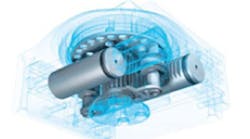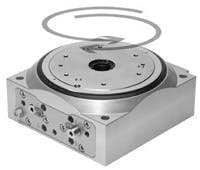Rotary indexing can easily be done with electrical tables, but they require drives and controls of a full servomotor system. Electrical tables undoubtedly have their place for ultimate control over position, acceleration, and speed, but Festo Corp., Northampton, U.K., has identified numerous applications where the functionality can be completely met by pneumatic systems at a lower initial cost, with far simpler controls, and less required maintenance.
Festo’s new DHTG ser ies of pneumatic rotary indexing tables are easy to install and commission, with all connections and adjustments accessible from only one side of the unit. They feature a stationary center section with a through hole that offers plenty of space for cables, tubing, and for mounting electrical slip rings, or a rotating union for additional automation on the rotating table.
Four sizes have table diameters of 65, 90, 140, or 220 mm, and throughholes are located in the top of the housing, with centering holes on the bottom — threaded holes and centering holes are also included on two sides for sizes 65 and 90. All of the connections and settings are made on the side; for example, for sensors, shock absorbers adjustment, and speed control.
Flexible design for versatility
DHTG pneumatic rotary indexing tables are ideally suited to fully or semiautomated applications, such as assembly and light machining operations. They handle mass moment of inertia to 1.2 kg m2, repetition accuracy of ±40 angular seconds, and a cycle frequency of 6.6 Hz. They can be used for clockwise or counterclockwise motion, and an optional conversion kit provides reciprocating motion for the 65 and 90 sizes. Moreover, different indexing can be selected subsequently as well.
The rotary movement is quiet and smooth, with near-sinusoidal acceleration. Inductive proximity detectors provide position feedback for control systems once the table is locked in position at the end of an index movement.
Whether in semi of fully automated pick-and-place machines, or swivelling or separating tasks, the indexing table provides gentle, reliable acceleration and smooth running characteristics. The overload-protected mechanism has a high tolerance for dust and oil.
The three sizes initially available — 90, 140, and 220 — are capable of generating 4.4, 18.1, and 58.9 N-m of torque, respectively. Each table can have 2, 4, 6, 8, 12, or 24 indexing points (stations), which can be driven clockwise, counterclockwise, or toggled between the two. The number of stations can also be modified to suit changes to application requirements. All models feature compact design; for example, the 90-mm table has a 130 149 mm footprint and height of 70 mm.
Safe handling
All three tables are equipped with adjustable hydraulic shock absorbers, and the 140-mm and 220-mm models also incorporate automatic overload protection facilities to guard against damage being caused by excessive mass moments of inertia.
Sensing is carried out with inductive sensors integrated into the housing. Overload protection ensures that the table gives way in the event of excessive tangential forces during rotation. End-position cushioning can be adjusted via a shock absorber adjusting screw, and emergency stops are cushioned for safe operation.
A wide range of accessories for the DHTG series rotary tables includes single- and multiple-port rotary air distributors, adapter kits, indexing conversion kits, toggle motion kits, proximity sensors, and connecting cables.
This information was provided by Nicola Meadway, of Festo Great Britain. For more information on DHTG indexing Circle XXX tables, call Festo’s USA facility, Hauppauge, N. Y., at (631) 435-0800, or visit www.festo.com/us.



